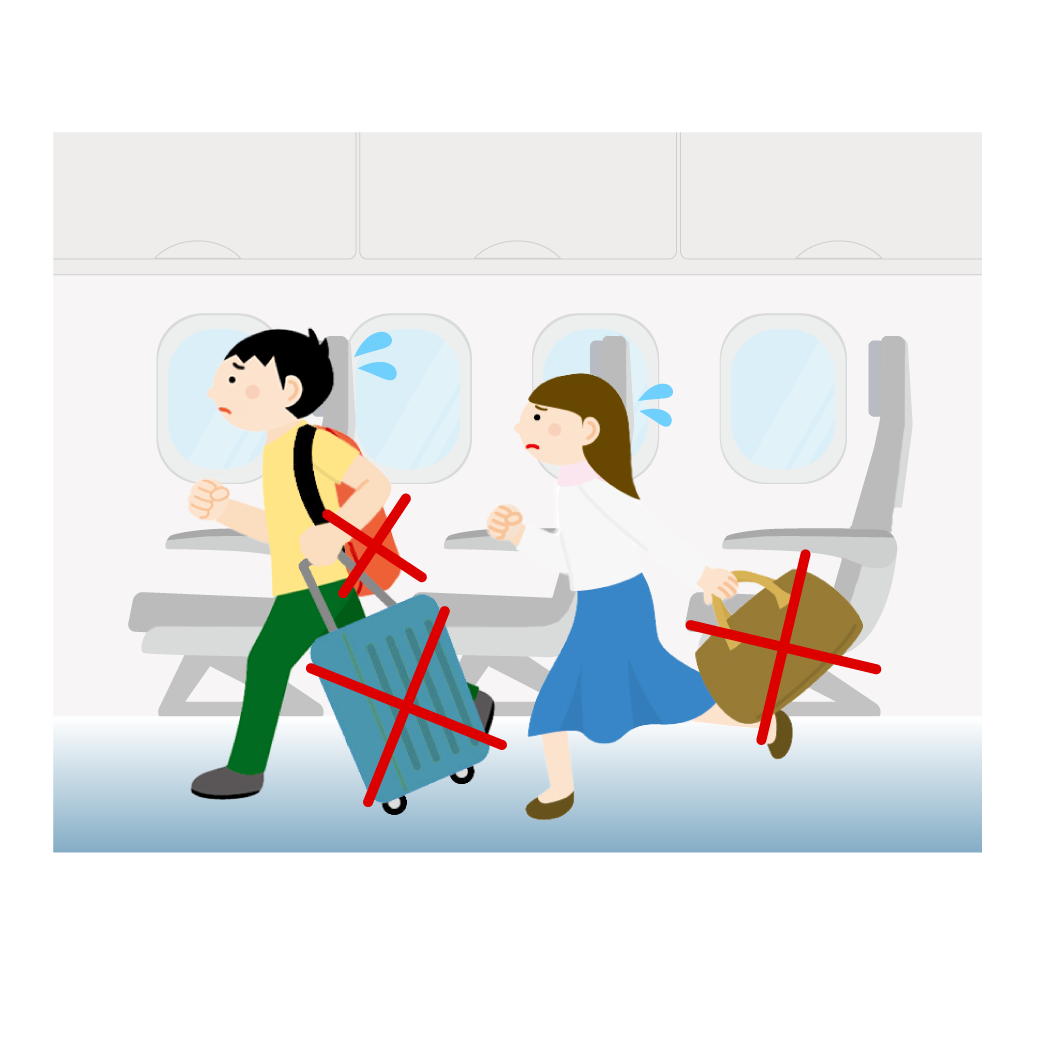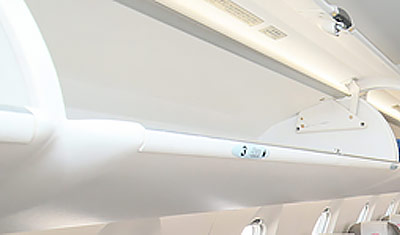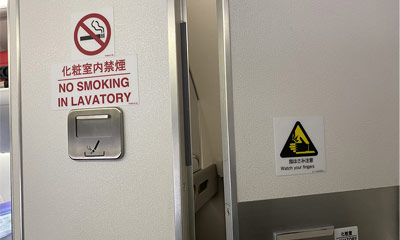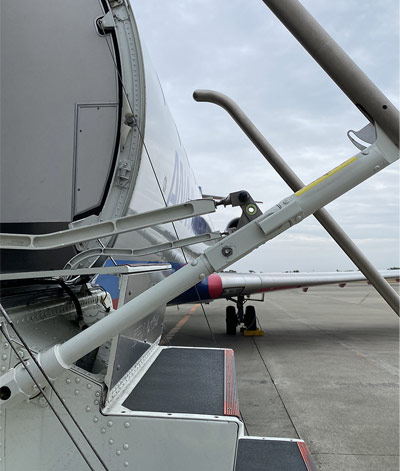Acts Prohibited by Law
The following acts are prohibited under Article 73 Paragraph 3 of the Civil Aeronautics Act of Japan and may be punishable with a maximum fine of JPY 500,000.
We appreciate your understanding and cooperation in this matter.
- Operating equipment to open/close doors, etc.
- Operating the handle/switch to open/close doors without being instructed to by the crew is extremely dangerous.
- Smoking in lavatories
- Smoking is not allowed in any part of the aircraft. (This includes imitation items such as electronic and smokeless tobacco products.) The risk of fire is particularly high when smoking in the lavatories.
- Hindering crew duties
- From a security perspective, the crew must not be obstructed in performing their duties due to abusive language, threats, sexual harassment, or similar by passengers who have consumed excessive amounts of alcohol, etc.
- Using prohibited electronic devices
- The use of cell phones or other such equipment on board may hinder flight operations.
When the aircraft doors close after boarding, please turn off such devices immediately upon hearing the relevant announcement from the cabin crew.
- Not wearing a seat belt
- You may cause injury not only to yourself but also other passengers if you are thrown into the air by sudden turbulence or similar.
- Not stowing your tray table or returning your seat to the upright position
- This may cause a hindrance in the event of an emergency evacuation.
- Leaving baggage in places that would hinder an emergency evacuation
- Leaving baggage in the aisles, etc., is dangerous as it may fly in all directions during sudden turbulence or similar. It may also cause a hindrance in the event of an emergency evacuation.
- Operating or moving items such as life vests or fire extinguishers, or acts rendering such items non-functional
-
Please refrain from the reckless use of emergency equipment such as life vests and fire extinguishers, as these are provided should an emergency occur.
Including the above acts, the acts below are prohibited as they are considered unruly behavior.
- (1)Acts affecting aircraft safety
- (2)Acts putting passengers or assets at risk
- (3)Acts disrupting order in the cabin
- (4)Acts violating cabin discipline
- Also other instances when there is sufficient reason to believe that one of the acts above will be carried out.
Request to Wear Seat Belt at All Times
When on board, we kindly request passengers keep their seat belts fastened at all times even when the seat belt sign is turned off, in readiness for any unexpected events that may occur.
There are belts to extend the seat belts attached to a seat. Please contact our cabin attendants if you require that.
Please note that your own extension belts brought by yourself cannot be used on board.
Request to Refrain from Smoking On Board
Smoking and the use of fire is strictly forbidden in all parts of the aircraft including the lavatories, as it may lead to the outbreak of fire. If the smoke detector is activated, this may result in a serious situation such as the aircraft having to return to the departure location or make an emergency landing at a nearby airport
- Electronic and Smokeless Tobacco
-
The use of smoking substitutes that do not use fire, such as electronic and smokeless tobacco, is prohibited on board out of consideration for other passengers, as it may lead to misunderstanding and cause unease or discomfort. (This also applies to odor- or steam-emitting products that do not contain nicotine or tar.)
- These items can still be brought on board as carry-on baggage.
- Bringing Lighters/Matches on Board
-
One cigarette lighter or box of small safety matches per person can be carried on board.
- Lighters containing oil tanks, cigar lighters, and premixed lighters (e.g., turbo lighters, jet lighters, lighters producing a powerful blue flame) cannot be carried on board or checked in.
To Passengers Sitting in Exit Row Seats
In order to ensure passenger safety in accordance with the Ministry of Land, Infrastructure, Transport and Tourism (MLIT), Japan circular, exit row seats are available only to passengers meeting all of the following conditions:
-
- (1)Passengers who are 15 years of age or older.
- (2)Passengers who do not require the assistance of an escort or staff when boarding.
- (3)Passengers able to assist upon emergency evacuation by opening/closing the aircraft doors, etc.
- (4)Passengers able to understand evacuation procedures and crew instructions and communicate these verbally to others.
- (5)Passengers able to communicate in Japanese or English.
- (6)Passengers who would not be required to assist accompanying passenger(s) in the case of an emergency evacuation.
- (7)Passengers agreeing to assist upon emergency evacuation.
- (8)Passengers not accompanied by a child under 8 years old.
- Baggage cannot be placed at your feet or on your lap.
-
In the event of an emergency, passengers seated in exit row seats are requested to assist with emergency evacuation by following the instructions of the cabin attendants so that the aircraft can be evacuated quickly. Cabin attendants will provide you the directions to perform some of the following tasks. Those not meeting the above conditions will be requested to move seats.
- - Keep other passengers away from the Emergency Exit Door until the cabin attendant securely opens it.
- - Follow the cabin attendants’ instructions. Open the Emergency Exit Door after confirming the safety outside the aircraft.
- - Have other passengers evacuate as quickly as possible.
- - Assist other passengers after evacuating from the aircraft, and direct other passengers to move away from the aircraft immediately.
- - Others (Cabin attendants will instruct other tasks when they are necessary.)
Emergency Evacuation Requests
In the event of an emergency, please follow the instructions of the cabin attendants and remain calm. Passengers sitting in Exit Row Seats or requested by a cabin attendant to assist in evacuation will be asked to assist with emergency evacuation. If you have any questions, please ask a cabin attendant.
- Emergency Evacuation
-
In the event of an emergency, please cooperate with the following points to exit the aircraft safely and quickly.
- Please refrain from taking carry-on baggage.
It may cause injury to yourself or other passengers, or block aisles and obstruct evacuation.
- Please remove high-heeled shoes when evacuating.
It may cause injury to yourself and delay your own evacuation.
- Photography and filming are prohibited.
It will delay your own evacuation and obstruct that of others.
Moving Seats
The engines on the CRJ700 are located at the aircraft rear, resulting in far more delicate balance in comparison to standard aircraft with main wing engines.
The aircraft's weight and balance is calculated prior to departure based on passengers taking their reserved seats. However, if passengers move to other seats, this changes the weight and balance and may affect how the aircraft takes off.
For safety reasons, IBEX Airlines checks prior to departure that passengers are sitting in their reserved seats.
If passengers move to other seats, the weight and balance will change, meaning recalculation will be required and thus potentially delaying the departure of the flight.
We would appreciate your understanding and cooperation in sitting in the seats you have reserved.
For your safety
Because the CRJ700 has a compact body, please note that the following information for your safety.
We would appreciate your understanding and cooperation.
Overhead compartments
- (1)Please watch the overhead when you get up from your seat.
- (2)Please be careful not to cut your finger with the clasp of the overhead compartments when opening.
Lavatory
Please be careful not to get your finger caught in the folding door when opening and closing.
Airstair (Stair for boarding)
Airstair of CRJ700 are very steep. Please hold on to the handrail and go up/down the stair slowly.



